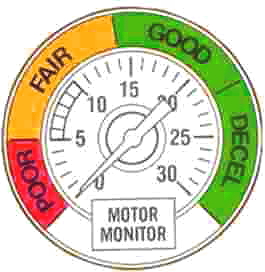 Reading the VACUUM gauge:
Reading the VACUUM gauge:
Many engine tuners optain state-of-the-art diagnostic equipment and have forgotten one of the simplest,
as well as most accurate tuning tools ...In most cases you can effectively monitor and tune your
car's fuel and timing systems using a quality vacuum gauge (like the
one we provide with our DIY systems).
First a few basics:
NOTE: connection to EFI cars is best done "Tee'd" into the
source line from the heater system. Other vacuum connections can
effect the idle speed as well
as information that the ECM needs to see.
- You must check and if necessary adjust the
ignition timing, valve clearance, sparck plug gap and contact angle of
the contact points.
- After the adjustments are made, you MUST
RESET your idle speed setting. You must do this to have a standard or
baseline to compare with.
- If you fine tune the LPG system small adjustments are best, and in fact
"optimum" settings on the vacuum gauge (highest reading)
is usually the maximum power. The mixture than is a little richer than it
stricktly needs to be. In other words, after the highest
reading is reached, the best setting (depending on engine) is to set
mixture screws back "lean" approximately 1/16 to 1/4 turn.
- If your system uses an ECOmax, you get the the best milage
when
the vacuum read out will be 5 upto 10 degrees lower. (For
more information see the instruction manual.)
What does the gauge tell you?
Let's see .... It can help you find errors in:
Incorrect mixture, a vacuum leak, leaking power valve, and more
...
When I was young, I was told to
effectively tune an engine with just the vacuum gauge and a timing
light. Once the education and practice is there, it is a very effective technique. It
takes some patience, but the knowledge of how your engine behaves to tuning changes is
worth it.
Detailed Vacuum gauge needle readings explained below (images at
right):
| Steady
needle |
Normal reading
(usually 17-22" Hg. in stock engines)
Race engines vary "a lot" and in most cases will be considerably less.
|
| Intermittent
fluctuation at idle |
Ignition miss,
sticking valves, lifter bleeding off (hydraulic), or just a BIG camshaft
|
| Low, though
steady reading |
Late timing,
low compression, sticking throttle valve, carb or manifold vacuum leak (remember most fast engines with a big cam and a tight centerline and
high overlap will be naturally low ... you must decide your baseline vacuum reading)
|
| Drifting
needle |
Improper carb
setting or minor vacuum leak
|
| Fluctuating
needle as RPM increases |
Ignition miss,
blown head gasket, leaking valve or weak or broken valve spring
|
| Steady, but
needle drops regularly |
Burnt valve or
incorrect valve setting (too tight), "needle will
fall when bad valve operates"
|
| Gradual
drop at idle |
Clogged
exhaust, excessive backpressure
|
| Excessive
vibration that steadies as RPM increases |
Worn valve
guides
|
|
Be aware!
some gauges turn clockwise some anti clock wise
Normal: (stock
engine)
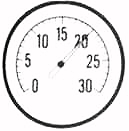
Clogged exhaust:
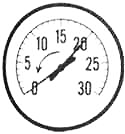
Blown head
gasket:
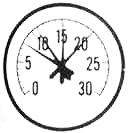
Incorrect
valve timing:

Worn out valve
guides:

Mixture adjustment
needed:

Sticking valves:
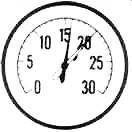
Burnt or
leaking valves:

|
|
 Reading the VACUUM gauge:
Reading the VACUUM gauge:






